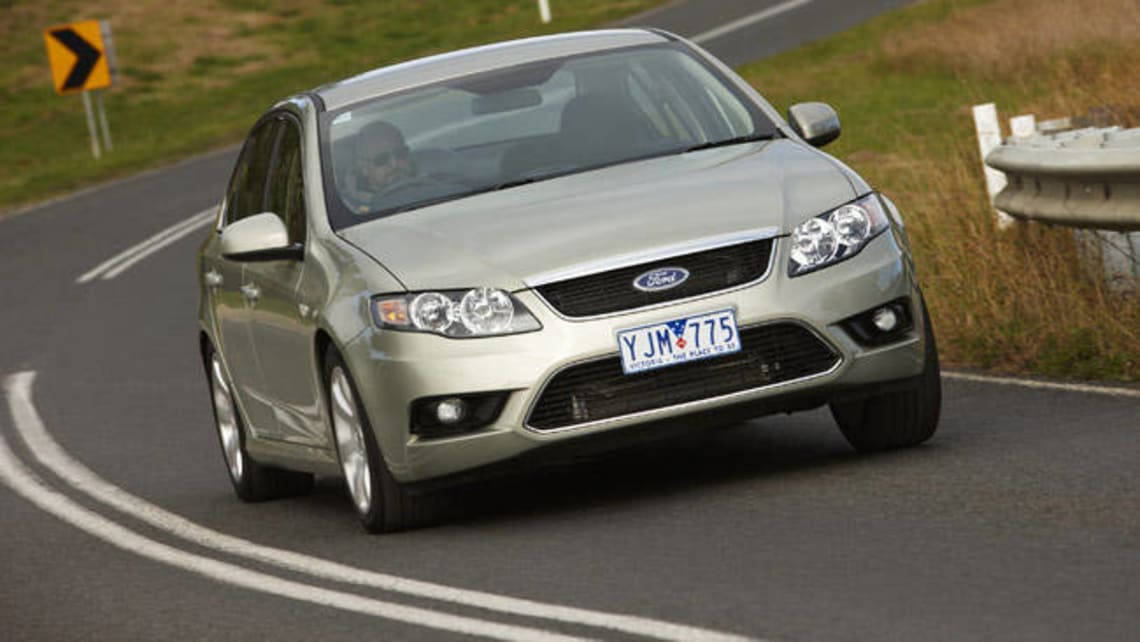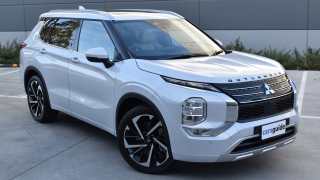
Used Ford Falcon review: 1997-2012
- Ford Falcon
- Ford Falcon 2008
- Ford Falcon 2009
- Ford Falcon 2004
- Ford Falcon 2005
- Ford Falcon 2006
- Ford Falcon 2001
- Ford Falcon 2007
- Ford Falcon 2010
- Ford Falcon 2002
- Ford Falcon 2011
- Ford Falcon 2012
- Ford Falcon 1997
- Ford Falcon 1998
- Ford Falcon 1999
- Ford Falcon 2000
- Ford Falcon 2003
- Ford Falcon Reviews
- Ford Reviews
- Ford Sedan Range
- Ford Wagon Range
- Ford Commercial Range
- Sedan
- Wagon
- Commercial
- Ford
- Used Car Reviews
- Buying tips
- Family Cars

Ford's Falcon is a rugged family car that copes well with rough and ready Australian bush roads so are very popular out there. They can be on the large side for close city work but have good outward visibility and a reasonably tight turning circle so aren’t too hard to drive in confined spaces.
The radical styling of the AU was years ahead of its time when it was introduced in September 1998 and many conservative buyers didn’t like it. Facelifts to create the AU Falcon Series II in April 2000 and to the AU III in November 2001 helped a bit. However, it wasn’t until September 2002 that a major facelift to produce the BA Falcon started to put the Falcon back into buyers’ minds again.
The BA Falcon was further upgraded to the BF Falcon in October 2005. Visual differences are minor, but there were significant changes to the transmissions at this time – more about them later. The introduction of the new FG series Falcon in May 2008 lifted awareness, but its shape was on the conservative side (it’s hard to please people…) and sales didn’t return to the record levels Falcon had enjoyed in the past.
Falcons have seating for five adults, though four makes more sense because the use of rear-wheel drive means the transmission tunnel takes up a lot of foot room in the centre-rear position. Legroom and headroom are ample for all but the largest adults.
Some find the relatively steep slope of the roof in the AU to BF series makes it awkward to get into the car. This applies to both front and back seats in sedans, naturally the back seat of the wagon doesn’t have this hassle. Comfort is very good and passengers can step out of a Falcon after a trip of hundreds of kilometres still feeling fresh and relaxed.
The boot in the sedan is rather shallow in the older models and the slope of the bootlid on the AU reduces its practicality. It’s easy to load thanks to a good-sized opening. The BA is noticeably better, though still on the shallow side. Falcon station wagons are great load carriers as they are built on a longer wheelbase than the sedan so they have a long, wide, practical cargo area.
The rear end of the BA is virtually identical to that of the older AU. Ford chose not to do an FG variant of the wagon. Instead, it created a Series III BF model to sell alongside the FG sedans. It wasn’t a success and was discontinued in 2010. Handling is surprisingly good for a car of this size and mass. You wouldn’t call it agile, but Falcons hold on when cornering at speeds far above those likely to be attempted by most drivers.
Ford's six-cylinder engines all have a capacity of 4.0 litres but come in several formats, including one with a turbocharger. An interesting variant on the six-cylinder is a dedicated LPG engine. These are very common in taxis, but less so in private cars, with the exception of Victoria, and the engine is all but indistinguishable from a petrol unit to drive. It’s quite a bit thirstier than the petrol, so fuel range suffers.
The standard AU six-cylinder unit is good enough, but the BA’s six-cylinder is noticeably smoother and offers even better performance. Ford fitted a 5.0-litre V8 to the AU, but it didn’t have a lot more performance than the six-cylinder units and was on the thirsty side. Much better were the BA bent eights: there was a choice of two, each with a capacity of 5.4 litres, one with a single-cam cylinder head, the other with a twin-cam setup.
An impressive four-cylinder turbocharged engine was introduced midway through 2012. It has plenty of power and torque and lower fuel consumption than the big engines. The four’s lighter weight gives the big car a nicely nimble feel during cornering. Automatics were all four-speed units until the launch of the BF, when a sophisticated six-speed ZF unit was installedlpg
The ZF was originally only fitted in the topline variants, with the rest of the range using the four-speed. With the introduction of the FG Falcon in May 2008 all received the six-speed auto, with the exception of the LPG power models, which stuck with the old four-speed unit. A six-speed auto was finally installed behind the new design of LPG engine in July 2011.
Manual gearboxes are rare and probably best avoided in all but the sporting XR6 and XR8 as they can affect resale value. The manual was a five-speed until the October 2005 BF series, when a six-speed was installed. Prices for spare parts, servicing and repairs are very reasonable and there are Ford dealers just about everywhere in Australia.
Most spare parts for the Falcons covered here are readily available, although a few bits on some older cars may have to come from a wrecker. These are very simple cars to work on, with plenty of underbonnet and undercar space. We recommend having a workshop manual at your elbow before starting the work.
Insurance prices are generally very reasonable and premiums for the everyday models are invariably at the lower end of the scale. It will generally cost more to cover a V8 Falcon than a straight-six, and be dearer again for a turbo six.
WHAT TO LOOK FOR
Rust is far less of a problem in these newer Falcons than old ones. To be on the safe side, check the door lower corners, door sill panels, mudguards and bootlid. If you do find serious rust the car may have been badly repaired after a crash.
Many thousands of used Falcons will have been taxis at some time in their life. Be wary of one running on dedicated LPG, while these are quite common in Victoria, they are rare anywhere else in Australia. Signs of an ex-taxi are vinyl, rather than cloth, upholstery, severe wear both inside and out, holes where signs and a taximeter have been removed, and possibly a paint respray.
Engine wear is indicated by a reluctance to start and by smoke from the exhaust and/or oil filler cap when the engine is revved. Four-speed automatics can cause problems on hard driven cars, especially the older models. Check they change gears cleanly and don't hunt up and down through the ratios. Be suspicious of any automatic that’s slow at going into gear from Neutral or Park.
Listen for a whining differential when driving at around 60 to 90km/h. Check the cabin for damage caused by wild kids. In station wagons have a good look at the load area for signs of commercial use.
CAR BUYING TIP
No matter how good a car looks on the surface it may have problems under the skin, never buy without a full inspection.
Pricing
| Year | Price From | Price To |
|---|---|---|
| 2012 | $6,600 | $27,720 |
| 2011 | $5,830 | $29,920 |
| 2010 | $4,950 | $28,930 |
| 2009 | $4,400 | $23,210 |
| 2008 | $3,190 | $22,330 |
| 2007 | $2,530 | $19,800 |
| 2006 | $2,530 | $18,700 |
| 2005 | $2,420 | $16,940 |
| 2004 | $2,200 | $15,620 |
| 2003 | $1,820 | $15,180 |
| 2002 | $1,820 | $15,180 |
| 2001 | $2,200 | $13,090 |
| 2000 | $2,200 | $12,320 |
| 1999 | $2,200 | $13,090 |
| 1998 | $2,310 | $13,090 |
| 1997 | $2,640 | $22,880 |
Pricing guides
Range and Specs
| Vehicle | Specs | Price* | |
|---|---|---|---|
| GLi Longreach | 4.0L, ULP, 4 SP AUTO | $3,300 – 5,170 | 1997 Ford Falcon 1997 GLi Longreach Pricing and Specs |
| Longreach Outback | 4.0L, ULP, 4 SP AUTO | $6,270 – 8,800 | 1997 Ford Falcon 1997 Longreach Outback Pricing and Specs |
| GLi Longreach Tradesman | 4.0L, ULP, 5 SP MAN | $4,730 – 6,930 | 1997 Ford Falcon 1997 GLi Longreach Tradesman Pricing and Specs |
| GLi Longreach | 4.0L, ULP, 5 SP MAN | $2,640 – 4,070 | 1997 Ford Falcon 1997 GLi Longreach Pricing and Specs |
$3,080
Lowest price, based on third party pricing data








